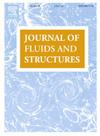Re-scaling of a fractional step method for low Reynolds number flows and fluid-structure-interaction
IF 3.4
2区 工程技术
Q1 ENGINEERING, MECHANICAL
引用次数: 0
Abstract
Fractional step methods, even with implicit time integration, suffer from severe time step restrictions at low Reynolds numbers (). Our analysis shows the splitting error of the implicit fractional step method is inversely proportional to the Reynolds number, which results in the time step restriction. Our solution involves introducing a new Reynolds number scaling in the fractional step method, which eliminates the restriction on time step size without sacrificing the accuracy of the results. We demonstrate the power of this simple scaling in two cases at low Reynolds numbers: (1) flow through a channel commonly encountered in microfluidic applications, and (2) fluid-particle interaction commonly arises in suspensions of micro- or nano-particles. Our results show that, with the new scaling, simulations for Reynolds numbers as low as = 0.0001 can be conducted using the same time step as for , which increases the size of time steps by 10000 folds, thereby reducing the computational cost/time. This simple re-scaling can easily be implemented in any fractional-step method.
低雷诺数流动和流固相互作用的分数阶方法的重新标度
分数阶方法,即使具有隐式时间积分,在低雷诺数(Re)下也会受到严重的时间步长限制。分析表明,隐式分步法的分裂误差与雷诺数成反比,从而导致了时间步长限制。我们的解决方案涉及在分数阶方法中引入新的雷诺数缩放,在不牺牲结果准确性的情况下消除了对时间步长的限制。我们在低雷诺数的两种情况下展示了这种简单缩放的力量:(1)流动通过微流体应用中常见的通道,以及(2)流体-颗粒相互作用通常出现在微或纳米颗粒悬浮液中。我们的研究结果表明,在新的尺度下,雷诺数低至Re= 0.0001的模拟可以使用与Re=1相同的时间步长进行,这将时间步长增加了10000倍,从而降低了计算成本/时间。这种简单的重新缩放可以在任何分数步方法中轻松实现。
本文章由计算机程序翻译,如有差异,请以英文原文为准。
求助全文
约1分钟内获得全文
求助全文
来源期刊

Journal of Fluids and Structures
工程技术-工程:机械
CiteScore
6.90
自引率
8.30%
发文量
173
审稿时长
65 days
期刊介绍:
The Journal of Fluids and Structures serves as a focal point and a forum for the exchange of ideas, for the many kinds of specialists and practitioners concerned with fluid–structure interactions and the dynamics of systems related thereto, in any field. One of its aims is to foster the cross–fertilization of ideas, methods and techniques in the various disciplines involved.
The journal publishes papers that present original and significant contributions on all aspects of the mechanical interactions between fluids and solids, regardless of scale.
 求助内容:
求助内容: 应助结果提醒方式:
应助结果提醒方式:


